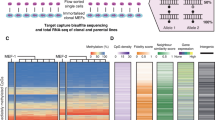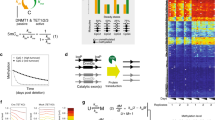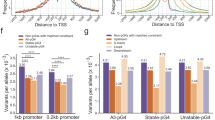Abstract
To gain insight into the function of DNA methylation at cis-regulatory regions and its impact on gene expression, we measured methylation, RNA polymerase occupancy and histone modifications at 16,000 promoters in primary human somatic and germline cells. We find CpG-poor promoters hypermethylated in somatic cells, which does not preclude their activity. This methylation is present in male gametes and results in evolutionary loss of CpG dinucleotides, as measured by divergence between humans and primates. In contrast, strong CpG island promoters are mostly unmethylated, even when inactive. Weak CpG island promoters are distinct, as they are preferential targets for de novo methylation in somatic cells. Notably, most germline-specific genes are methylated in somatic cells, suggesting additional functional selection. These results show that promoter sequence and gene function are major predictors of promoter methylation states. Moreover, we observe that inactive unmethylated CpG island promoters show elevated levels of dimethylation of Lys4 of histone H3, suggesting that this chromatin mark may protect DNA from methylation.
This is a preview of subscription content, access via your institution
Access options
Subscribe to this journal
Receive 12 print issues and online access
$209.00 per year
only $17.42 per issue
Buy this article
- Purchase on Springer Link
- Instant access to full article PDF
Prices may be subject to local taxes which are calculated during checkout








Similar content being viewed by others
Accession codes
References
Li, E., Bestor, T.H. & Jaenisch, R. Targeted mutation of the DNA methyltransferase gene results in embryonic lethality. Cell 69, 915–926 (1992).
Li, E., Beard, C. & Jaenisch, R. Role for DNA methylation in genomic imprinting. Nature 366, 362–365 (1993).
Heard, E., Clerc, P. & Avner, P. X-chromosome inactivation in mammals. Annu. Rev. Genet. 31, 571–610 (1997).
Egger, G., Liang, G., Aparicio, A. & Jones, P.A. Epigenetics in human disease and prospects for epigenetic therapy. Nature 429, 457–463 (2004).
Ioshikhes, I.P. & Zhang, M.Q. Large-scale human promoter mapping using CpG islands. Nat. Genet. 26, 61–63 (2000).
Klose, R.J. & Bird, A.P. Genomic DNA methylation: the mark and its mediators. Trends Biochem. Sci. 31, 89–97 (2006).
Boyes, J. & Bird, A. Repression of genes by DNA methylation depends on CpG density and promoter strength: evidence for involvement of a methyl-CpG binding protein. EMBO J. 11, 327–333 (1992).
Hsieh, C.L. Dependence of transcriptional repression on CpG methylation density. Mol. Cell. Biol. 14, 5487–5494 (1994).
Brandeis, M., Ariel, M. & Cedar, H. Dynamics of DNA methylation during development. Bioessays 15, 709–713 (1993).
Bird, A. DNA methylation patterns and epigenetic memory. Genes Dev. 16, 6–21 (2002).
Futscher, B.W. et al. Role for DNA methylation in the control of cell type specific maspin expression. Nat. Genet. 31, 175–179 (2002).
Song, F. et al. Association of tissue-specific differentially methylated regions (TDMs) with differential gene expression. Proc. Natl. Acad. Sci. USA 102, 3336–3341 (2005).
Walsh, C.P. & Bestor, T.H. Cytosine methylation and mammalian development. Genes Dev. 13, 26–34 (1999).
Warnecke, P.M. & Clark, S.J. DNA methylation profile of the mouse skeletal alpha-actin promoter during development and differentiation. Mol. Cell. Biol. 19, 164–172 (1999).
Smiraglia, D.J. et al. Excessive CpG island hypermethylation in cancer cell lines versus primary human malignancies. Hum. Mol. Genet. 10, 1413–1419 (2001).
Coulondre, C., Miller, J.H., Farabaugh, P.J. & Gilbert, W. Molecular basis of base substitution hotspots in Escherichia coli. Nature 274, 775–780 (1978).
Shen, J.C., Rideout, W.M., III. & Jones, P.A. The rate of hydrolytic deamination of 5-methylcytosine in double-stranded DNA. Nucleic Acids Res. 22, 972–976 (1994).
Hendrich, B., Hardeland, U., Ng, H.H., Jiricny, J. & Bird, A. The thymine glycosylase MBD4 can bind to the product of deamination at methylated CpG sites. Nature 401, 301–304 (1999).
Neddermann, P. & Jiricny, J. The purification of a mismatch-specific thymine-DNA glycosylase from HeLa cells. J. Biol. Chem. 268, 21218–21224 (1993).
Rollins, R.A. et al. Large-scale structure of genomic methylation patterns. Genome Res. 16, 157–163 (2006).
Saxonov, S., Berg, P. & Brutlag, D.L. A genome-wide analysis of CpG dinucleotides in the human genome distinguishes two distinct classes of promoters. Proc. Natl. Acad. Sci. USA 103, 1412–1417 (2006).
Weber, M. et al. Chromosome-wide and promoter-specific analyses identify sites of differential DNA methylation in normal and transformed human cells. Nat. Genet. 37, 853–862 (2005).
Takai, D. & Jones, P.A. Comprehensive analysis of CpG islands in human chromosomes 21 and 22. Proc. Natl. Acad. Sci. USA 99, 3740–3745 (2002).
Gardiner-Garden, M. & Frommer, M. CpG islands in vertebrate genomes. J. Mol. Biol. 196, 261–282 (1987).
Kim, T.H. et al. A high-resolution map of active promoters in the human genome. Nature 436, 876–880 (2005).
Peters, A.H. & Schubeler, D. Methylation of histones: playing memory with DNA. Curr. Opin. Cell Biol. 17, 230–238 (2005).
Schubeler, D. et al. The histone modification pattern of active genes revealed through genome-wide chromatin analysis of a higher eukaryote. Genes Dev. 18, 1263–1271 (2004).
Hwang, D.G. & Green, P. Bayesian Markov chain Monte Carlo sequence analysis reveals varying neutral substitution patterns in mammalian evolution. Proc. Natl. Acad. Sci. USA 101, 13994–14001 (2004).
Su, A.I. et al. A gene atlas of the mouse and human protein-encoding transcriptomes. Proc. Natl. Acad. Sci. USA 101, 6062–6067 (2004).
Assou, S. et al. The human cumulus–oocyte complex gene-expression profile. Hum. Reprod. 21, 1705–1719 (2006).
Koslowski, M. et al. Frequent nonrandom activation of germ-line genes in human cancer. Cancer Res. 64, 5988–5993 (2004).
Choi, Y.C. & Chae, C.B. DNA hypomethylation and germ cell-specific expression of testis-specific H2B histone gene. J. Biol. Chem. 266, 20504–20511 (1991).
Singal, R. et al. Testis-specific histone H1t gene is hypermethylated in nongerminal cells in the mouse. Biol. Reprod. 63, 1237–1244 (2000).
Schubeler, D. et al. Genomic targeting of methylated DNA: influence of methylation on transcription, replication, chromatin structure, and histone acetylation. Mol. Cell. Biol. 20, 9103–9112 (2000).
Eckhardt, F. et al. DNA methylation profiling of human chromosomes 6, 20 and 22. Nat. Genet. 38, 1378–1385 (2006).
Bock, C. et al. CpG island methylation in human lymphocytes is highly correlated with DNA sequence, repeats, and predicted DNA structure. PLoS Genet 2, e26 (2006).
Ayton, P.M., Chen, E.H. & Cleary, M.L. Binding to nonmethylated CpG DNA is essential for target recognition, transactivation, and myeloid transformation by an MLL oncoprotein. Mol. Cell. Biol. 24, 10470–10478 (2004).
Lee, J.H. & Skalnik, D.G. CpG-binding protein (CXXC finger protein 1) is a component of the mammalian Set1 histone H3-Lys4 methyltransferase complex, the analogue of the yeast Set1/COMPASS complex. J. Biol. Chem. 280, 41725–41731 (2005).
Roh, T.Y., Cuddapah, S. & Zhao, K. Active chromatin domains are defined by acetylation islands revealed by genome-wide mapping. Genes Dev. 19, 542–552 (2005).
Bird, A.P. Gene number, noise reduction and biological complexity. Trends Genet. 11, 94–100 (1995).
Maatouk, D.M. et al. DNA methylation is a primary mechanism for silencing postmigratory primordial germ cell genes in both germ cell and somatic cell lineages. Development 133, 3411–3418 (2006).
Pohlers, M. et al. A role for E2F6 in the restriction of male-germ-cell-specific gene expression. Curr. Biol. 15, 1051–1057 (2005).
De Smet, C., Loriot, A. & Boon, T. Promoter-dependent mechanism leading to selective hypomethylation within the 5′ region of gene MAGE-A1 in tumor cells. Mol. Cell. Biol. 24, 4781–4790 (2004).
Davuluri, R.V., Grosse, I. & Zhang, M.Q. Computational identification of promoters and first exons in the human genome. Nat. Genet. 29, 412–417 (2001).
Carrel, L. & Willard, H.F. X-inactivation profile reveals extensive variability in X-linked gene expression in females. Nature 434, 400–404 (2005).
Eisenberg, E. & Levanon, E.Y. Human housekeeping genes are compact. Trends Genet. 19, 362–365 (2003).
Simpson, A.J., Caballero, O.L., Jungbluth, A., Chen, Y.T. & Old, L.J. Cancer/testis antigens, gametogenesis and cancer. Nat. Rev. Cancer 5, 615–625 (2005).
Li, Z. et al. A global transcriptional regulatory role for c-Myc in Burkitt's lymphoma cells. Proc. Natl. Acad. Sci. USA 100, 8164–8169 (2003).
Riesewijk, A.M. et al. Monoallelic expression of human PEG1/MEST is paralleled by parent-specific methylation in fetuses. Genomics 42, 236–244 (1997).
Muller, F. & Tora, L. The multicoloured world of promoter recognition complexes. EMBO J. 23, 2–8 (2004).
Acknowledgements
We thank members of the Schübeler laboratory for advice during the course of the project and comments on the manuscript; E. Oakeley for generating scripts for data reformatting, A. Peters, M. Lorincz, C. Alvarez, P. de Boer, E. Selker and M. Groudine for critical reading of the manuscript. Primary samples from kidney and colon were obtained from M. Haase (Dresden University of Technology). Work in the laboratory of D.S. is supported by the Novartis Research Foundation, the EU 6th framework program NOE 'The Epigenome' (LSHG-CT-2004-503433) and a European Molecular Biology Organization (EMBO) Young Investigator Award. I.H. is supported by an EMBO long-term fellowship (ALTF 1160-2005).
Author information
Authors and Affiliations
Contributions
M.W. designed and performed experiments and analysis and wrote the manuscript. D.S. designed the study and wrote the manuscript. M.B.S. performed housekeeping annotations and wrote custom software. M.R. performed CpG classifications and promoter confidence analysis, retrieved genomic information and contributed to the writing of the manuscript. I.H. and S.P. performed divergence analysis and contributed to the writing of the manuscript. L.R. provided purified human samples.
Corresponding author
Ethics declarations
Competing interests
The authors declare no competing financial interests.
Supplementary information
Supplementary Fig. 1
Validation of the spatial filtering of oligos. (PDF 202 kb)
Supplementary Fig. 2
Reproducibility of microarray experiments. (PDF 160 kb)
Supplementary Fig. 3
Higher promoter methylation on the X chromosome compared with autosomes. (PDF 106 kb)
Supplementary Fig. 4
Bisulfite genomic sequencing of CpG island promoters. (PDF 199 kb)
Supplementary Fig. 5
DNA methylation of active LCP promoters. (PDF 184 kb)
Supplementary Fig. 6
Comparison of promoter DNA methylation patterns between sperm and primary fibroblasts. (PDF 162 kb)
Supplementary Table 1
Promoter DNA methylation of germline-specific genes in primary fibroblasts and sperm. (PDF 52 kb)
Supplementary Table 2
Primer sequences. (PDF 54 kb)
Rights and permissions
About this article
Cite this article
Weber, M., Hellmann, I., Stadler, M. et al. Distribution, silencing potential and evolutionary impact of promoter DNA methylation in the human genome. Nat Genet 39, 457–466 (2007). https://doi.org/10.1038/ng1990
Received:
Accepted:
Published:
Issue Date:
DOI: https://doi.org/10.1038/ng1990



